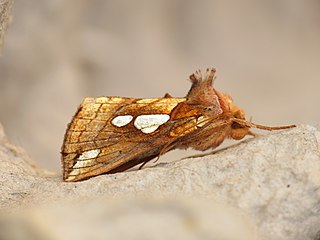
Plusiinae is a smallish subfamily of the moth family Noctuidae. As the Noctuidae appear to be a paraphyletic assemblage, the Plusiinae may eventually be raised to family status.

Agrotis puta, the shuttle-shaped dart, is a moth of the family Noctuidae. The species was first described by Jacob Hübner in 1803. It is common in the western part of Europe, but is also found in southern and central Europe, as well as North Africa and the Middle East.

Diachrysia chrysitis, the burnished brass, is a species of moth of the family Noctuidae. It is found in Europe, the Caucasus, Russia, Russian Far East and Siberia. In the south of Europe the range extends to southern Spain, southern Italy and the Balkan peninsula. It is lacking on most of the Greek Islands. In the north it extends into almost to the Arctic Circle and far north Russia. In the east the range extends to the Amur region and Japan.

Panthea coenobita is a species of moth of the family Noctuidae. It is found in North Europe, East Europe and Southern Europe, the central and northern European part of Russia, Japan, Korea, northern China, the Russian Far East, southern and western Siberia and Turkey.

Panchrysia is a genus of moths of the family Noctuidae.

Euchalcia variabilis, the purple-shaded gem, is a moth of the family Noctuidae.

Euxoa temera is a moth of the family Noctuidae. It is found in Central and Southern Europe, North Africa, the Caucasus, Armenia, Central Asia, Turkey, Iraq and Iran.

Atethmia ambusta is a moth of the family Noctuidae. It is found in Central Europe and parts of Southern Europe to Western Asia.

Panchrysia v-argenteum is a moth of the family Noctuidae. It is found in the Carpathian mountains, Dalmatia, the Alps and Greece. The species is found high altitudes of up to 1,400 meters.

Globia algae, the rush wainscot, is a moth of the family Noctuidae. The species was first described by Eugenius Johann Christoph Esper in 1789. It is found in central and southern Europe, Turkey, Armenia, northern Caucasus, south-west Siberia.

Phragmatiphila nexa is a moth of the family Noctuidae. It is found locally in Central Europe, north to Denmark, southern Sweden, and southern Finland. Westward, it is found up to north and central France, south to Switzerland, northern Italy, Austria and southern Hungary. Eastward, it is found to Poland, the Baltic states, and the European part of the former Soviet Union up to western Siberia. Furthermore, there are isolated populations in central Italy, in Sardinia, and in Corsica.

Mythimna sicula is a species of moth of the family Noctuidae. It is found from Morocco to Libya, central and southern Europe, Turkey, Israel, Iran and Turkmenistan.

Plusia putnami, the Lempke's gold spot or Putnam's looper moth, is a species of moth of the family Noctuidae. It is found in the Palearctic realm, from Japan and eastern Siberia to Fennoscandia, Great Britain, and France. In North America, it ranges from Newfoundland and Labrador to central Alaska and the interior of British Columbia, south to Pennsylvania, Washington, north-eastern California, and in the Rocky Mountains to Utah and Colorado.

Panthea virginarius, the Cascades panthea, is a moth of the family Noctuidae. It is mainly found west and north of the Great Basin, from the coast of southern California northward to the Queen Charlotte Islands of British Columbia and the Alaskan Panhandle, eastward to central California, northern Nevada, Idaho, north-western Wyoming, western Montana, and south-western Alberta. A disjunct population is found in the Cypress Hills of Alberta and Saskatchewan.

Heliothis ononis, the flax bollworm, is a moth of the family Noctuidae. The species was first described by Michael Denis and Ignaz Schiffermüller in 1775. It is found in China, Kazakhstan, central Asia, northern Mongolia (Khangai), the Russian Far East, the Korean Peninsula, southern European part of Russia, southern and central Europe, southern and eastern Siberia and Turkey. In North America it is found from south-central Manitoba west to British Columbia, north to the Northwest Territories and Yukon and Alaska and south to Colorado.

Amphipyra livida is a moth in the family Noctuidae. It is found in central and southern Europe, although strays are known from further north. It is also known from Anatolia to Korea, China and Japan.

Lycophotia molothina is a species of moth in the family Noctuidae. It is distributed throughout south-western and central Europe and is found wherever its food plants grow. It is traditionally thought of as a species of heathland.

Panchrysia ornata is a species of moth of the family Noctuidae. It is found from the Ural Mountains, through Siberia, Mongolia, Sikhote-Alin and the Paektu Mountains to Kamchatka and the Pacific coast. It is found up to altitudes of 2,400 meters.

Hoplodrina superstes, also known as the powdered rustic, is a moth of the family Noctuidae, first described by Ferdinand Ochsenheimer in 1816. It is found in Asia and Europe.

Panchrysia dives is a moth of the family Noctuidae. It is found from the Ural, east through southern Siberia to the Pacific Ocean. The range includes Kamchatka, Sakhalin and the Kuriles.



















